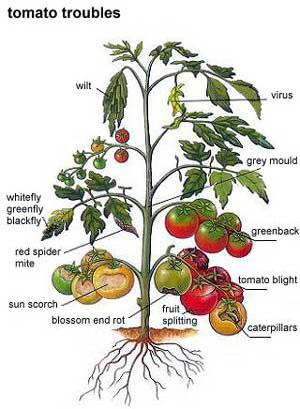Tomato Troubles?
More Information
Tomato problems may be caused by nutrient deficiencies, diseases, fungi or insects.
Assess the symptoms, then make the appropriate treatment.
Plant tomatoes where they will get at least 10 hours of light in summer. Leave room between plants for air to circulate. Alternate growing areas for tomatoes and you diminish the risk of soil-borne diseases such as bacterial spot and early blight. Plant your tomato seedlings up to the first true leaves.New roots will quickly sprout on the stems. More roots means more fruits.
1. Yellowing Leaves
Yellowing and discolored leaves where the veins are still green is a sign of either a phosphorous or calcium deficiency. Amend this with an organic fertilizer, try epsom salts. Learn more about epsom salts here: https://backyarddiva.ca/garden-tips-6/
2. Insects
Horn worm, aphids, moth and beetles can cause severe damage to your fruit. Remove and destroy insects as soon as possible. Use an organic natural pesticide spray to help deter the smaller insects. Recipe here: https://backyarddiva.ca/homemade-natural-pesticide/
3. Splitting Fruit
Like the foliage that’s dying back, splitting tomato fruit is a sign of uneven watering. As the fruit is ripening if the plant receives too much water the skin will split because the fruit’s skin can no longer expand. Provide your plants with a good 2 – 3″ inch layer of organic mulch such as straw, pine needles, or shredded bark. This will maintain more regular soil moisture levels, and you’ll deal with less splitting.
4. Sun Scorch
Sun scorch is irreversible once it’s impacted a tomato, but its progression can be slowed. You can leave exposed fruit on the vine and cover it with lightweight screen, shade cloth, or straw to protect if from further damage. You can also harvest scorched tomatoes and let them finish ripening on a windowsill or kitchen counter.
5. Greenback
Greenback is a disorder which generally occurs in greenhouse grown tomatoes. The area around the stalk does not. It remains resolutely green or yellow and tougher in texture. A combination of factors including too little potassium and phosphorous and too much direct sunlight and high heat are to blame. Cover your tomatoes with a shade screen, plenty of ventilation and amend soil with organic fertilizer.
6.Grey Mould/Leaf Mould
Leaf mould can develop rapidly to cause significant yield loss in greenhouse-grown tomatoes. It is rarely seen on outdoor crops. Provide ample ventilation to avoid an excessively moist atmosphere. Try to avoid wetting the leaves when watering. This is particularly important when watering in the evening, as the leaves may then stay wet throughout the night. Pick off infected leaves as soon as they are seen, and dispose of affected plants and all debris at the end of the season.
7. Blossom End Rot
Blossom end rot generally develops when the fruit’s demand for calcium exceeds the supply in the soil. This may result from low calcium levels in the soil, drought stress, excessive soil moisture, temperature fluctuations due to rain or over watering . This disease does not spread from plant to plant in the field, nor from fruit to fruit. Tomatoes planted early in cold soil are likely to develop blossom end rot on the first fruits, planting tomatoes in warmer soils helps to alleviate the problem. Add more calcium to your tomatoes when they begin to bloom: espom salts and/or milk is a great way to get that calcium to your tomatoes.
8. Tomato Blight
Blight is caused by fungus, symptoms tend to become prevalent during the hotter months. This disease produces brown to black spots on older leaves. If severe, the fungus also attacks stems and fruit. Affected leaves may turn yellow, then drop, leaving the fruit exposed to sunburn. Sanitation is the best control. Remove all diseased plant tissue on the ground, as the fungus overwinters on leaf debris. Do not plant tomatoes in the same place next year. Space plants farther apart to improve air circulation. Avoid overhead irrigation.


